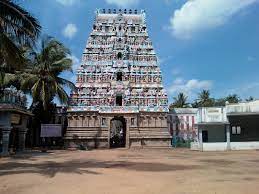Rahu Stalam is a Hindu temple dedicated to the deity Shiva, located in Tirunageswaram. It is significant to the Hindu sect of Saivism as one of the temples associated with the nine planet elements, the Navagraha Stalas, and specifically Rahu. Shiva is worshipped as Naganathar and is represented by the lingam.
Shrine’s History
The temple is another masterpiece which exhibits the Chola style of architecture. It is believed to have been built by Aditya Chola I in the 10th century A.D. Later rulers modified the temple with their own additions. The temple has a separate shrine for Rahu.
Legends Associated with This Shrine
Many serpents, including Adishesha, Takshaka and Karkotaka, worshipped Shiva at this place, leading to the name “Tirunageswaram”. As per Hindu legend, the king of snakes, Adisesha did penance at this place, called Senbaranya Kshetram on account of the presence of a large number of Senbaga trees. Shiva was pleased by the penance and appeared to him. Since Shiva gave a boon to the king of Serpents, he is called Naganathar. A Goddess Girigujambal is believed to be worshipping Shiva here with goddesses Lakshmi, Saraswathi, Ganesha, Muruga, and Shasta. Maha Bhairava is still believed to be guarding and assisting the divine mother during her prayers. The Goddess is said to be Swayambu as she is present in the form of Meru.
Hence, no abhisheka is performed for the image. As per a Hindu legend, Indra was cursed by sage Gautama as he misbehaved with the latter’s wife Ahalya. To obtain deliverance from the sage’s curse, it is said that Indra worshipped Giri-Gujambigai with a scented material termed Punugu for 45 days. Sages like Gautama and Parashara and kings like Bhagiratha and Nala are said to have worshipped Naganathar at this place. The name “Kumbakonam”, translated into English as the “Jug’s Corner”, is believed to be an allusion to the mythical pot of the Hindu god Brahma that contained the seed of all living beings on earth.
The Kumbha is believed to have been displaced by a pralaya and ultimately came to rest at the spot where the town of Kumbakonam now stands. The drops of nectar are believed to have fallen onto five shrines around Kumbakonam, namely Mahlingeswarar temple at Tiruvidaimarudur, Tirudharasuram, Naganathar Temple at Tirunageswaram, Tiruvorgam and Tirupadalavanam.
Shrine’s Map Location and How to Go There
By Road
Direct bus is available from Kumbakonam to Karaikal, temple is 7 km from Kumbakonam
By Rail
1)The railway station is available at Thirunageswaram, only passengers will stop here. Passenger Trains are Tambaram – Kumbakonam and Kumbakonam – Mayiladuthurai. 2)Kumbakonam is well-connected railway station with all parts of South India 3)Next nearest stations are at Tiruvidaimarudur which is 5 km from Thirunageswaram
By AirTiruchirapalli is the nearest domestic airport which is 109 km away.
Shrine Timings
5:30 a.m. to 10 p.m.
Events Celebrated at This Shrine
The Brahmotsvam or prime festival is celebrated for ten days in the Tamil month of Karthigai ,Shivratri,Kandasashti festival is celebrated for six during October or November every year when Murugan, the son of Shiva.
